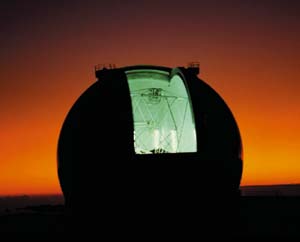 n 1917, Albert
Einstein and other physicists believed our own Galaxy was all there was
to the universe -- a uniformly dense collection of stars and other matter
floating in the void. The problem was, Einstein's new General Theory of
Relativity would not allow for a static universe.
n 1917, Albert
Einstein and other physicists believed our own Galaxy was all there was
to the universe -- a uniformly dense collection of stars and other matter
floating in the void. The problem was, Einstein's new General Theory of
Relativity would not allow for a static universe.
So Einstein fudged; to get rid of the possibility of expansion or contraction,
he introduced into his equations a term called the cosmological constant.
Although other solutions were also possible, the value he gave the cosmological
term at least permitted the universe to be static.
Edwin Hubble revealed in 1929 that the universe was full of numberless
galaxies, that their light was redshifted -- its frequency reduced, like
the lowered pitch of a fire truck's siren as it races away -- and that
the light from more distant galaxies was redshifted farther than closer
ones. It was immediately clear that the universe really is expanding.
Einstein called the cosmological constant "the biggest blunder of my
life." Doubly so: not only was it unneeded, without it he might have
predicted the expansion of the universe.
The question is not as simple as Edwin Hubble's first observations
suggested, however. The redshifts of distant objects are greater than
their distances imply if the universe were expanding at a constant rate.
In fact the expansion rate was higher in the past. But how fast is it
slowing down, and is the deceleration continuing?

|
(Click on image to enlarge)
|
|
Two images from the Cerro Tololo Observatory in Chile show a region of sky just before and after a supernova appears. The third image shows the same supernova as seen by the Hubble Space Telescope, a sharper picture that allows a better measurement of the supernova's apparent brightness, and thus its distance.
|
If the universe is sufficiently dense, someday the galaxies will stop their outward rush and fall back upon themselves in a Big Crunch. Less
density, and the galaxies will escape to infinity, resulting in a Big
Chill. It's also possible that the galaxies will slow ever more gradually,
almost -- but never quite -- coming to rest. This is the alternative favored
in the popular Inflationary theory proposed in 1979 by Alan Guth, which
nicely cleans up a number of messy questions about the structure of
the universe and its parts.
The Supernova Cosmology Project looks into the distant past by looking
at distant objects in space. To estimate distance, astronomers use "standard
candles," objects whose intrinsic brightness is the same wherever they
are found (named to suggest an ordinary wax candle that, if it is seen
across a room, for example, looks dimmer than it does up close). Type
Ia supernovas are superb candles, stellar explosions so bright that
for a few days they can be brighter than entire galaxies. They can be
seen across billions of light-years.
First astronomers have to catch the supernovas in the act of exploding -- a
rare chance event until the Supernova Cosmology Project developed a
novel technique. Ground-based telescopes in Chile and elsewhere take
pictures of small patches of sky, enough to include a thousand galaxies
at a time. The same fields are recorded again three weeks later, both
to take advantage of the dark of the moon, and, says Gerson Goldhaber,
who helped develop the technique, "because we want to catch the supernova
before it reaches its maximum brightness." Any new bright spot in the
field is a supernova candidate.
"Prior to 1992, before the technique was fully evolved, no very high-redshift
supernovas had been found," says Goldhaber, but with the new method
"and better access to powerful telescopes, the rate of discoveries has
been increasing exponentially." Team members using the Keck telescope
in Hawaii over the 1997 Christmas holidays discovered 15 new Type Ias,
bringing the total so far to more than 60.
Ground-based telescopes peering through the Earth's shifting atmosphere
can separate the spectrum and brightness of an extremely distant supernova
from that of its home galaxy, but only with difficulty. "We first proposed
using the exquisite imaging capabilities of the Hubble Space Telescope
two years ago," says Saul Perlmutter, "once we had proven that we could
supply it with large numbers of distant supernova discoveries 'on demand.'"
| Lead scientists on this project
|
|
|
|
|
|
On January 8, 1998, Perlmutter announced the results of the first 40
supernovas the team had analyzed, including one studied with aid of
the Hubble Space Telescope. The brightness of the most distant revealed
that its light had been traveling toward Earth for seven billion years,
half the age of the universe. Together, their redshifts showed that
the universe had been expanding faster in the past, but it wasn't slowing
down fast enough to stop -- and in fact may now be starting to accelerate
again.
"All the indications from our observations of supernovas spanning a
large range of distances are that we live in a universe that will expand
forever," Perlmutter says. "Apparently there isn't enough mass in the
universe for its gravity to slow the expansion, which started with the
Big Bang, to a halt."
But if Inflationary theory is correct (perhaps even if it isn't), some
factor besides gravity may be involved.
"With a large enough sample of data of the kind we can expect routinely
from the Hubble Space Telescope," Goldhaber says, "we now believe it
will be possible to independently measure the effects of gravity and
the cosmological constant."
When Einstein called the cosmological constant his biggest blunder,
he may have spoken too soon.
- Paul Preuss




